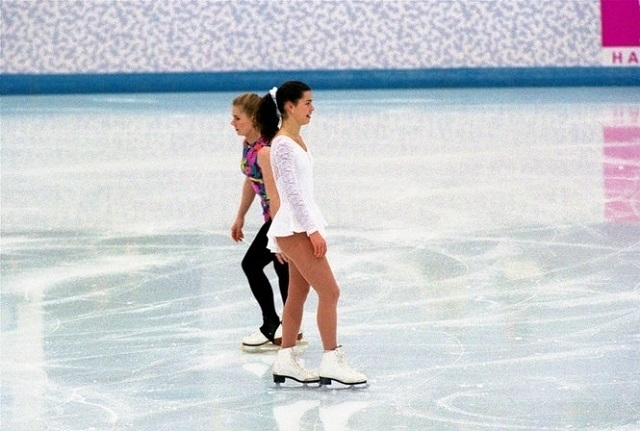7 best Winter Olympic rivalries in history

Rivalries have long been an integral part of sports, and at the Olympics, the world’s a stage. The Summer Olympics may have their winter cousin beat by sheer numbers, but some of the most captivating rivalries have played out in the snow or on the ice. Here are seven of them, in no particular order:
Tara Lipinski / Michelle Kwan
When it comes to figure skating, there are few things Americans love more than cheering on “the future” — the darling, talented teenager who is taking the figure skating world by storm. But at the 1998 Winter Olympics in Nagano, Japan, the U.S. had two figure-skating darlings: 17-year-old Michelle Kwan and 15-year-old Tara Lipinski.
Lipinski was the reigning world champion and had the potential to become the youngest gold medalist in history. Kwan was a consistent winner whose routines were known tear-jerkers. They both skated nearly perfectly, but Lipinski’s more technical routine ultimately gave her the gold, and Kwan was the one left crying.
Battle of the Brians
The 1988 figure skating rivalry between American Brian Boitano and Canadian Brian Orser at the Calgary Olympics is better remembered as the “Battle of the Brians.”
Orser took silver at the 1984 Olympics, while Boitano placed fifth. Orso placed second at the 1985 World Figure Skating Championships and Boitano placed right below him, but the two switched places the next year. In 1987, when Orser won the World Championship, Boitano started looking to the Calgary Olympics for redemption.
It was a close decision, but the judges decided 5-4 to give Boitano the gold. Orser went home with the silver medal.
Italian-Norwegian cross country skiing
Cross-country skiing isn’t must-watch Olympics for most people, but the event has been occasion for a hard-fought battle between Italy and Norway since the 1994 Olympics in Lillehammer, Norway.
Norway had been the strongest cross-country ski team for years before the Games. The teams had been neck-and-neck for nearly two hours when they reached the finish line. Despite Norway having the home advantage, it was the Italians who won the day — and by less than a second, sparking a rivalry that continues today.
Battle of Carmens
The 1988 Calgary Olympics also saw a similarly named figure skating rivalry: the “Battle of the Carmens.” American Debi Thomas and East German Katarina Witt independently chose to skate to Bizet’s opera “Carmen” in their long programs, and most people expected one of the two to win gold.
The finish wasn’t as dramatic as that of the Brians, though: Underwhelming free skates affected their scores, and while Witt still ended up taking gold, Thomas went home with the bronze.
Nancy Kerrigan / Tonya Harding
The drama that had everyone’s attention at Lillehammer wasn’t the cross-country upset, though. It was one of the most bizarre things that has happened in Olympic history that captivated the world heading into the Games.
Gold medal favorite Nancy Kerrigan was clubbed in the knee on Jan. 6, 1994, in an attack planned by the ex-husband of Tonya Harding, Kerrigan’s figure skating rival.
Both Kerrigan and Harding went on to compete in the 1994 Olympics, Kerrigan just seven weeks after the attack, and their short program remains the sixth-most-watched TV show of all time. According to ESPN, 48.5 percent of American households tuned in to watch the tension-filled show.
Kerrigan went on to win silver, finishing second to Oksana Baiul. Harding finished eighth.
U.S. / Canada
Despite being friendly neighbors, the U.S. and Canada have what is perhaps the Olympics’ most intense rivalry. The rivalry is played out most fiercely in the hockey rink, where the two countries are easily the best in the world.
The U.S. men and women have won more medals in ice hockey than any other country at 25. Canada is a close second with 24. However, Canada has the most gold medals with 11, compared to just three for the U.S.
Men’s hockey is competitive, to be sure, but it’s the women’s teams that really make the rivalry brutal. Both countries have four medals in women’s hockey and games against any other teams are really just warm-ups.
The U.S. won the 2013 World Championships, but Canada, out for revenge Wednesday night, won a preliminary game 3-2 on a controversial go-ahead goal. A ref blew his whistle as the puck closed in on the goal line, and the question became whether the whistle came before or after the puck had crossed the line. It was ultimately called a good goal, despite appearing to many to have been short.
US / USSR
The U.S. and Russia have one of the most competitive rivalries in sport, long fueled by political differences. Of course, the most famous example of this is the “Miracle on Ice”: Heading into the 1980 Lake Placid Olympics, the Soviet Union was considered a virtual certainty to win the gold medal in the men’s ice hockey tournament. The ‘Big Red Machine’ had won gold at the previous four Olympics and boasted a team packed with seasoned players fully supported by the State and professional in everything but name.
By comparison, the United States had won just one medal in the same period and had to pick their team from university students because professionals were not allowed to compete under the rules at the time, according to Reuters.
In the medal round at Lake Placid, the U.S. pulled off one of the greatest upsets in ice hockey history by winning 4-3 in a game that became known as the “Miracle on Ice.” The U.S. went on to win the gold while the USSR took silver.
Reuters contributed to this report.
Contact Stephanie Grimes at sgrimes@reviewjournal.com. Find her on Twitter: @steph_grimes